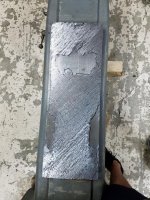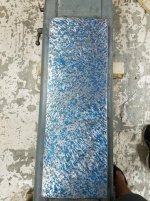Thunderdog
Plastic
- Joined
- May 25, 2018
Hi all,
Let me start by saying that I'm a learning and don't have all of the answers. So, I'm posting my current status and plan to scrape my Wells-Index Super 55(I hope that is an acceptable machine to discuss on this site).I began this process a few weeks ago with some beginning guidance from Richard King at a different site. He has not been there in a while and so here I am. Plus there are several other experienced individuals here who definitely know alot more than me. (Richard, if you see this I would like to touch base with you regarding your Ohio scraping class.)
Anyway, I laid the column down and took some prints with my CI surface plate. I measured the amount of wear on the face of the column to be about .0005". I have scraped the face of the column to 10-12 p.p.i. I know many will laugh at this, but it is a major accomplishment for myself.
Current progress:


MY PLAN MOVING FORWARD
(Please advise if I'm missing something or getting it wrong.)
1. Measure the dovetail wear again using my little jig. Video seen below. This mill does not lend itself to measure with pins due to rough casting beside the dovetail.
Most of the wear occurs at approximately 7" from the top of the dovetail with about .0035" movement of the indicator.
2. Roll the column on it's side. (Should I do sliding or gib dovetail first? Does it matter regarding the order?)
3. Remove necessary material at the bottom of the dovetail to avoid having the straight edge bottom out and produce a false reading.
4. Make bluing prints to identify high spots.
5. Scrape from high to low.
Unknowns/Need some clarity from the pros:
Dovetail is not necessarily concerned with any precise angle provided you scrape straight down from original scraped surface to the lowest point, correct?
To prevent scraping the dovetails into a wedge(from top of column to bottom of column) I should continue checking with my little measuring jig(video seen above), correct?
What else am I missing or have I overlooked something super obvious?
Let me start by saying that I'm a learning and don't have all of the answers. So, I'm posting my current status and plan to scrape my Wells-Index Super 55(I hope that is an acceptable machine to discuss on this site).I began this process a few weeks ago with some beginning guidance from Richard King at a different site. He has not been there in a while and so here I am. Plus there are several other experienced individuals here who definitely know alot more than me. (Richard, if you see this I would like to touch base with you regarding your Ohio scraping class.)
Anyway, I laid the column down and took some prints with my CI surface plate. I measured the amount of wear on the face of the column to be about .0005". I have scraped the face of the column to 10-12 p.p.i. I know many will laugh at this, but it is a major accomplishment for myself.
Current progress:


MY PLAN MOVING FORWARD
(Please advise if I'm missing something or getting it wrong.)
1. Measure the dovetail wear again using my little jig. Video seen below. This mill does not lend itself to measure with pins due to rough casting beside the dovetail.
2. Roll the column on it's side. (Should I do sliding or gib dovetail first? Does it matter regarding the order?)
3. Remove necessary material at the bottom of the dovetail to avoid having the straight edge bottom out and produce a false reading.
4. Make bluing prints to identify high spots.
5. Scrape from high to low.
Unknowns/Need some clarity from the pros:
Dovetail is not necessarily concerned with any precise angle provided you scrape straight down from original scraped surface to the lowest point, correct?
To prevent scraping the dovetails into a wedge(from top of column to bottom of column) I should continue checking with my little measuring jig(video seen above), correct?
What else am I missing or have I overlooked something super obvious?


 , on way out so just to give my non pro 2 cents.
, on way out so just to give my non pro 2 cents.